Crassula pellucida
Crassula pellucida L.
Family: Crassulaceae
Common names: trailing crassula (Eng.); rankplakkie (Afr.); inyamayamakhwenkwe (isiXhosa)
Introduction
Crassula pellucida is a beautiful, low-growing, creeping and spreading, perennial succulent plant with starry flowers and decorative leaves, that makes an excellent groundcover or container plant.

Description
Description
The stems are decumbent or prostrate, branched, up to 600 mm long. The leaves are small, 10–25 × 5–12 mm, ovate to rounded, usually sharply acute, usually hairless, green, sometimes with brown stripes, with a faintly toothed margin that is colourless or red. The leaves are opposite and have no stalk (are sessile) or have a barely visible stalk (up to 8 mm long), so that it appears as if the leaf-base is fixed around the stem, without any stalk. This feature helps to distinguish this species from the similar and closely related Crassula spathulata. The tiny, 3–5 mm long, star-shaped, white or pale pink flowers are in clusters held slightly above the leaves and sometimes half hidden by the leaves, in spring and summer (Sep. to Feb.). The flowerhead is carried at the end of a stem, in the axil of a leaf, and it does not have a distinct peduncle (stalk of an inflorescence), although each individual flower has a pedicel (flower stalk). This is also a useful way to distinguish it from similar crassulas. Occasionally, only a single flower will be produced.
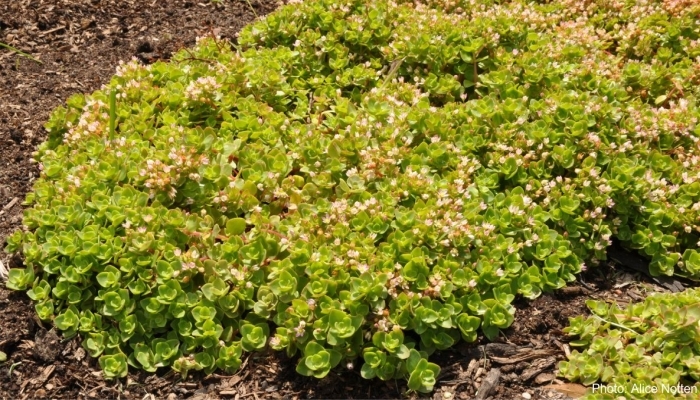
In suitable conditions Crassula pellucida will form a cushion-like mass.
Conservation Status
Status
Crassula pellucida has no threat status. None of the subspecies is threatened, early in the twenty first century, although one (subsp. spongiosa) is Rare, growing in a small area of the Northern Cape.
Distribution and habitat
Distribution description
Crassula pellucida is a very variable species and has five recognised subspecies. Three of them are endemic, the other two are also found in neighbouring countries in southern Africa and into tropical Africa.

Subspecies pellucida, western trailing crassula, has hairless branches. The leaves with a petiole (petiolate) or without a petiole (sessile), the opposite leaf blades are free, obovate to broadly elliptic, blunt tipped (obtuse) or tipped with a short point (apiculate), margins are irregularly papillose (small, pimple-like protuberances). The flowerhead is usually a terminal dichasium (each flowering stem gives rise to two lateral flowering stems on either side), and occasionally a single flower is produced. The calyx is about two thirds as long to as long as the corolla. Flowering is in spring to midsummer (Nov. to Feb.). It occurs in the Western Cape and Eastern Cape, from the Winterhoek Mountains, to the Cape Peninsula to the Swartberg Mountains and near Swellendam, usually on rock outcrops in shaded, moist places or in forests.
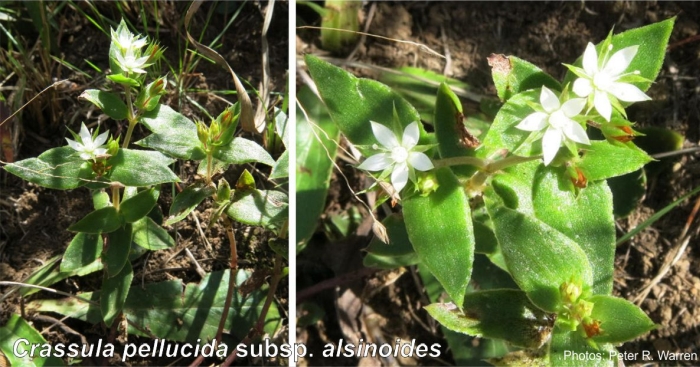
Subspecies alsinoides, northern or single-flowered trailing crassula, produces a single, star-shaped white flower in the axil of a leaf. Flowering is in spring and summer (Oct. to Mar.). Leaves are sessile, ovate to lanceolate-spathulate, taper to a point (acute), with a sharp point, margins with elongate papillae making them appear minutely dentate (serrulate). Internodes hairy. It occurs in the northern parts of South Africa, mainly in Limpopo and Mpumalanga and rarely in Eastern Cape, KwaZulu-Natal, and is widespread and common in tropical Africa, in moist shaded places, often in forests along streams or in swamps.

Subspecies brachypetala, common or short-petalled trailing crassula, has hairy internodes at least along a line on either side of the stem. Leaves are sessile to petiolate, lanceolate to ovate, acute, cuneate, with irregularly spreading pappillae along the margins. The inflorescence is a terminal dichasium, the pedicels are hairy. The calyx is as long as or longer than the petals. Flowering is during summer (Dec. to Apr.). It is a common, widespread and variable species that occurs in Eastern Cape, Free State, KwaZulu-Natal, Limpopo and Mpumalanga and in tropical Africa, in moist areas in grassveld, forest margins, often on rocky outcrops.

Subspecies marginalis, eastern or fused-leaf trailing crassula, has hairless branches. The leaves are sessile, with the blades of opposite leaves being fused to one another to form a disc up to 10 mm in diameter. Its leaves are broadly ovate, with a pointed apex and a horny margin without papillae. The inflorescence is 1 to 3 terminal dichasia, often appearing umbellate, and pedicels are not hairy. The calyx is usually about half as long as the corolla. Flowering is in spring and early summer (Sep. to Dec.). It occurs along the southeastern coast of South Africa, in Eastern Cape, from George to East London, usually on rock outcrops, in shaded, moist places or in forest.
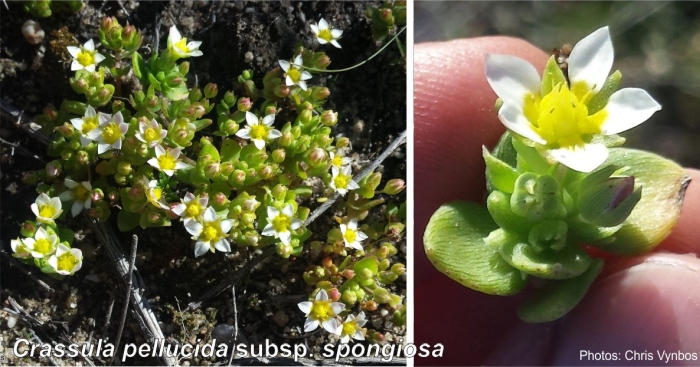
Subspecies spongiosa, Bokkeveld or spongy trailing crassula, is a hairless, decumbent annual that occurs on the Bokkeveld Escarpment between Nieuwoudtville and Calvinia, growing in sandy soil in sheltered kloofs. Leaves elliptic, often with a colourless point at the tip. Fowering is in spring (Oct. to Nov.) and the calyx, carpels and receptacle become spongy after flowering.
Derivation of name and historical aspects
History
The name Crassula is the diminutive of the Latin crassus, which means ‘thick’ or ‘fat’, referring to the fleshy nature of the genus as a whole. The species name pellucida means ‘transparent’ or ‘translucent’ and may refer to the calyx which typically has a membranous margin and may be almost colourless, or to the carpels and receptacle that are soft and transparent when fruiting. The subspecific epithet alsinoides means ‘resembling the former genus Alsine, now Minuartia, commonly called sandwort’; brachypetala means ‘with short petals’; marginalis means ‘marginal’ for the dryish, often red leaf margins; and spongiosa means ‘spongy’.
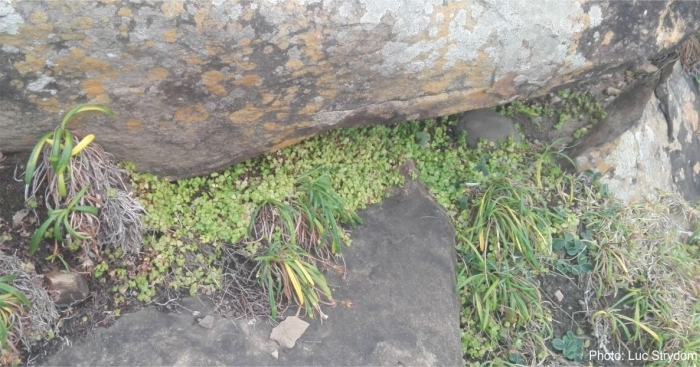
Ecology
Ecology
Crassula pellucida occurs in shaded, rocky, forested areas, typically where some moisture might be available. The succulent nature of the plants allows them to survive periods of drought. The stems root easily, allowing the plant to spread and colonise new areas when conditions are favourable. If a single leaf or a piece of stem falls on suitable ground it is able to make roots and become an independent plant, this allows them to survive being trampled or damaged.
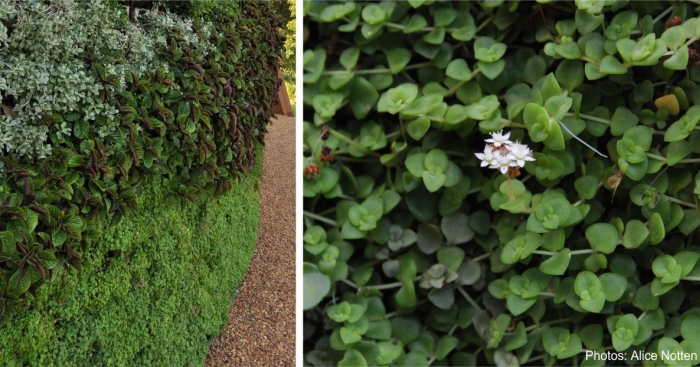
Uses
Use
There are no known medicinal or cultural uses for this plant. It is a popular and rewarding ornamental plant, ideal for rockeries, terraces and retaining walls, and it makes an excellent groundcover in semi-shade or shade. It is well suited to cultivation in containers and hanging baskets and was one of the plants used in the ‘living wall’ in the Untamed exhibition at Kirstenbosch in 2011. Plants in sunnier situations tend to develop reddish colour in the leaves and stems and flower more than those growing in full shade.

Growing Crassula pellucida
Grow
Crassula pellucida is easy to grow and requires well-drained soil and a temperate to warm climate. These plants are generally started by division, leaf and stem cuttings, or seeds. Stems tend to root as they grow, and rooted pieces can be gently uprooted, cut off from the mother plant and replanted. When propagating by cuttings, carefully remove a healthy stem or leaf from the mother plant, place the cut end in rooting medium, and keep moist and cool. To propagate from seeds, sow the seeds in a free-draining soil mixture in spring, or autumn in the Western Cape. Keep the seed tray moist, warm and shaded. Propagation can be done outdoors, but in a cooler areas or where frost may occur, indoor propagation is recommended.
Plants are susceptible to mealy bug and fungal diseases and should be kept in an area that has free air circulation and low humidity, and should be planted in well-drained soil and not overwatered, as with all succulents.
References
- Braun K. 2012. Observation of Crassula pellucida subsp. brachypetala, Malolotja Nature Reserve, Eswatini. iNaturalist. Online. https://www.inaturalist.org/observations/10955491.
- Eggli, U. & Newton, L.E. 2004. Etymological Dictionary of succulent plant names. Springer, Berlin.
- Jackson, W.P.U. 1990. Origins and meanings of names of South African plant genera. University of Cape Town.
- Manning, J. & Goldblatt, P. 2012. Plants of the Greater Cape Floristic Region 1: the Core Cape Flora. Strelitzia 29. South African National Biodiversity Institute, Pretoria.
- Raimondo, D., Von Staden, L., Foden, W., Victor, J.E., Helme, N.A., Turner, R.C., Kamundi, D.A. & Manyama, P.A. (eds) 2009. Red list of South African plants. Strelitzia 25. South African National Biodiversity Institute, Pretoria.
- Strydom L. 2019. Observation of Crassula pellucida subsp. brachypetala, Haga Haga, EC. iNaturalist. Online. https://www.inaturalist.org/observations/33640042
- Toelken, H.R. 1985. Crassulaceae. Flora of Southern Africa 14: 1–229.
- Van Berkel, N. 2011. Observation of Crassula pellucida subsp. marginalis, Keurbooms, EC. iNaturalist. Online. https://www.inaturalist.org/observations/10801785
- Vynbos, C. 2018. Observation of Crassula pellucida subsp. spongiosa, locality obscured, NC. iNaturalist. Online. https://www.inaturalist.org/observations/16927238.
- Warren P. 2014. Observation of Crassula pellucida subsp. alsinoides, Umgeni Nature Reserve, KZN. iNaturalist. Online. https://www.inaturalist.org/observations/10961273.
Credits
Samuel Lekhetho
Free State National Botanical Garden
and Alice Notten
Kirstenbosch National Botanical Garden
June 2022
Acknowledgments: the authors thank Kate Braun, Luc Strydom, Nicola van Berkel, Chris Vynbos and Peter Warren for making their images available via iNaturalist.
Plant Attributes:
Plant Type: Ground Cover, Succulent
SA Distribution: Eastern Cape, Free State, KwaZulu-Natal, Limpopo, Mpumalanga, Northern Cape, Western Cape
Soil type: Sandy
Flowering season: Spring, Early Summer, Late Summer
PH: Acid, Neutral
Flower colour: White, Pink
Aspect: Shade, Morning Sun (Semi Shade), Afternoon Sun (Semi Shade)
Gardening skill: Easy
Special Features:
Horticultural zones










Rate this article
Article well written and informative
Rate this plant
Is this an interesting plant?
Login to add your Comment
Back to topNot registered yet? Click here to register.